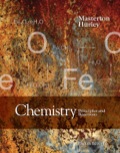
Concept explainers
Selenious acid, H2SeO3, is primarily used to chemically darken copper, brass, and bronze. It is a diprotic acid with the following Ka values:
Interpretation:
The pH of solution, the concentration of
Concept introduction:
The dissociation reaction of a weak acid is represented as follows:
The expression for the acid dissociation constant will be as follows:
Here,
The pH of the solution is calculated as follows:
Here,
Answer to Problem 62QAP
The pH of solution is 1.054, the concentration of
Explanation of Solution
The molecular formula of selenium acid is
The molarity of solution is 2.89 M.
The concentration of each species can be calculated using the ICE table as follows:
Now, the second ionization reaction is represented as follows:
According to above two ICE tables, the equilibrium concentration of
The expression for dissociation constant is as follows:
Putting the values,
Similarly, the expression for the second ionization constant is as follows:
Putting the values,
Since, the second dissociation constant is very low thus; the value of y can be neglected from the denominator in the equation (2)
Thus, the value of y is
From the ICE table, it is concentration of
Now, in the equation (1),
Calculate the ratio of acid dissociation constant and concentration of acid; if it is less than 0.05 then the value of x from the denominator can be neglected.
The calculated value is less than 0.05 thus,
Or,
Putting the value of y in the above equation,
Or,
Thus, the concentration of
Putting the values,
The concentration of
Putting the values,
The pH of the solution can be calculated as follows:
Putting the values,
Therefore, the pH of solution is 1.054, the concentration of
Therefore, the pH of solution is 1.054, the concentration of
Want to see more full solutions like this?
Chapter 13 Solutions
EBK CHEMISTRY: PRINCIPLES AND REACTIONS
- Identify the missing organic reactants in the following reaction: X + Y H+ two steps Note: This chemical equation only focuses on the important organic molecules in the reaction. Additional inorganic or small-molecule reactants or products (like H2O) are not shown. In the drawing area below, draw the skeletal ("line") structures of the missing organic reactants X and Y. You may draw the structures in any arrangement that you like, so long as they aren't touching. Click and drag to start drawing a structure. Х :arrow_forwardDraw the mechanism of friedel-crafts acylation using acetyl chloride of m-Xylenearrow_forwardI need help naming these in IUPACarrow_forward
- H R Part: 1/2 :CI: is a/an electrophile Part 2 of 2 Draw the skeletal structure of the product(s) for the Lewis acid-base reaction. Include lone pairs and formal charges (if applicable) on the structures. 4-7: H ö- H Skip Part Check X :C1: $ % L Fi Click and drag to start drawing a structure. MacBook Pro & ㅁ x G 0: P Add or increase positive formal cha Save For Later Submit ©2025 McGraw Hill LLC. All Rights Reserved. Terms of Use | Privacy Centearrow_forwardDraw the friedel-crafts acylation mechanism of m-Xylenearrow_forwardDon't used hand raiting and don't used Ai solutionarrow_forward
- 1. Base on this experimental results, how do you know that the product which you are turning in is methyl 3-nitrobenzoate(meta substituted product ) rather than either of the other two products? 2. What observation suggests that at least a small amount of one or both of the other two isomers are in the mother liquor?arrow_forwardExplain Huckel's rule.arrow_forwardhere is my question can u help me please!arrow_forward
 Chemistry & Chemical ReactivityChemistryISBN:9781337399074Author:John C. Kotz, Paul M. Treichel, John Townsend, David TreichelPublisher:Cengage Learning
Chemistry & Chemical ReactivityChemistryISBN:9781337399074Author:John C. Kotz, Paul M. Treichel, John Townsend, David TreichelPublisher:Cengage Learning Chemistry & Chemical ReactivityChemistryISBN:9781133949640Author:John C. Kotz, Paul M. Treichel, John Townsend, David TreichelPublisher:Cengage Learning
Chemistry & Chemical ReactivityChemistryISBN:9781133949640Author:John C. Kotz, Paul M. Treichel, John Townsend, David TreichelPublisher:Cengage Learning ChemistryChemistryISBN:9781305957404Author:Steven S. Zumdahl, Susan A. Zumdahl, Donald J. DeCostePublisher:Cengage Learning
ChemistryChemistryISBN:9781305957404Author:Steven S. Zumdahl, Susan A. Zumdahl, Donald J. DeCostePublisher:Cengage Learning Chemistry: An Atoms First ApproachChemistryISBN:9781305079243Author:Steven S. Zumdahl, Susan A. ZumdahlPublisher:Cengage Learning
Chemistry: An Atoms First ApproachChemistryISBN:9781305079243Author:Steven S. Zumdahl, Susan A. ZumdahlPublisher:Cengage Learning
 Chemistry: The Molecular ScienceChemistryISBN:9781285199047Author:John W. Moore, Conrad L. StanitskiPublisher:Cengage Learning
Chemistry: The Molecular ScienceChemistryISBN:9781285199047Author:John W. Moore, Conrad L. StanitskiPublisher:Cengage Learning





